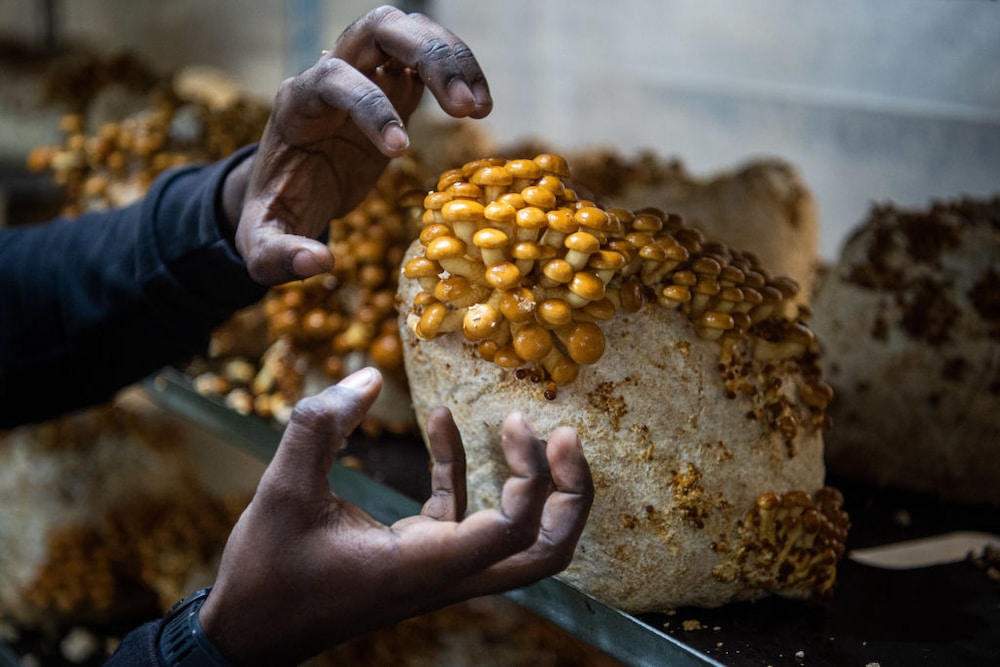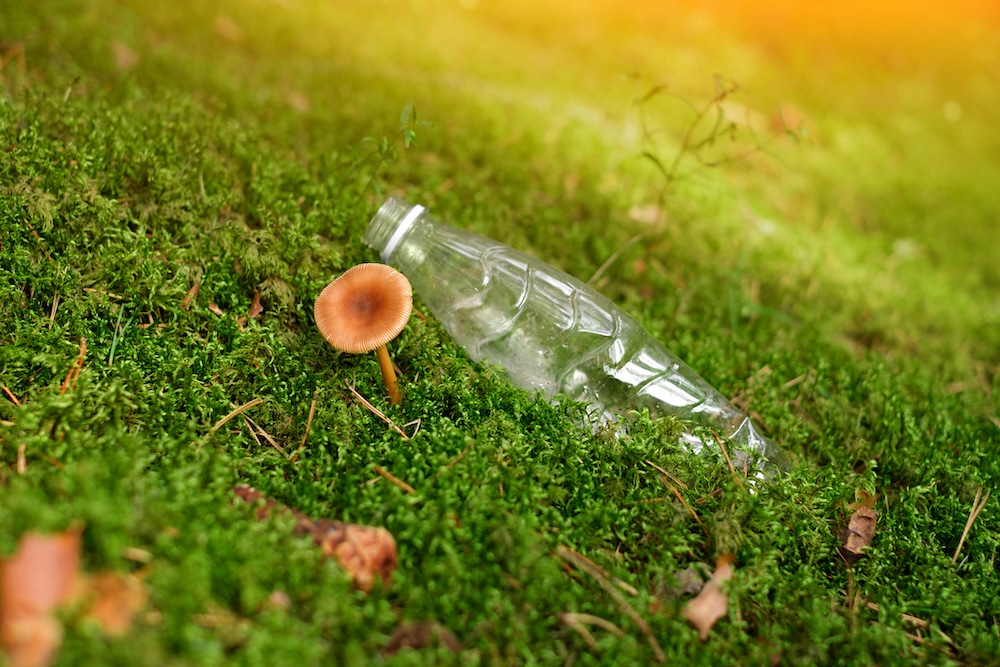
Yes!
The 2 to 4 million species of fungi in the world offer us endless possibilities — from creating alternative building materials and textiles, to cleaning up environmental toxins, to providing new sources of plant-based proteins. Now, scientists are turning to mushrooms and mycoremediation to solve our plastic pollution crisis.
What Is Mycoremediation?

Mushrooms growing at a habitat restoration site in Hylebos Creek, Tacoma, Washington in 2010. Port of Tacoma / Flickr
Mycoremediation is a form of bioremediation: the introduction of microorganisms or other life forms to break down environmental pollutants in contaminated areas. Bioremediation is employed to clean up oil spills, industrial sites, brownfields and even Superfund sites, often introducing bacteria to degrade the pollutants and cycle nutrients back into the environment. Mycoremediation is different in that it uses fungi instead of bacteria. Mycelia — the thread-like root systems of fungi that grow underneath the mushroom — consume food externally, using their enzymes to break down molecules in pollutants and toxins. Basically, they digest the surface they’re growing on and convert it into nutrients.

It’s a remarkable method that’s been used to clean up industrial and agricultural waste — like cyanotoxins, herbicides and pesticides — and sometimes convert them into edible, high-protein mushrooms. Mushrooms have been used to clean up oil spills, contaminated soil and heavy metals in brownfields. Oyster mushrooms are capable of removing E. coli from contaminated waters, such as the highly contaminated Chicago River, as well as toxin-filled ash from wildfires that make their way into waterways.

And now, we’re beginning to see their potential to break down one of our generation’s most widespread pollutants: plastic.
Potential Uses
Landfills and Marine Plastic Patches
Plastic doesn’t decompose, but merely breaks down into smaller pieces over time. That means that the 8.3 billion tons of plastic that have been produced since the 1950s still exists in one form or another. Landfills, where 27 million tons of plastic have accumulated since 2018, are a particular concern. How, though, can mushrooms be used to break down plastic in these airless, sunless environments?
Pestalotiopsis microspora might be the answer. A 2011 study out of Yale University declares that this rare mushroom — found by students on a class research trip to Ecuador’s Amazon rainforest — can degrade a common type of polymer plastic called polyester polyurethane, along with several other fungi in the Pestalotiopsis genus. These fungi can use plastic as their main source of carbon, converting it into organic matter. Pestalotiopsis microspora can even do so in both liquid and soil suspensions in dark environments without oxygen, meaning it could be useful in landfills, waste treatment centers and even in ocean plastic gyres like the Great Pacific Garbage Patch. Working quickly, it decomposes parts of the plastic in just two weeks.

In 2017, scientist Sehroon Khan of the Kunming Institute of Botany collected Aspergillus tubingensis growing in a city garbage dump in Islamabad, Pakistan. He found that the fungus was able to break down polyurethane — a plastic used widely in producing large appliances, fake leather, sponges, and synthetic fibers — within weeks. The mushroom’s enzymes and mycelia work to break bonds between molecules and then break them apart.
Non-Recyclable Material
Not all plastics can be recycled, or it’s extremely difficult to do so. Polypropylene, for example, accounts for 28% of global plastic waste, but a meager 1% of it is recycled. It’s used to create household items like toys, industrial products like car parts, plastic packaging like takeout containers and cling film, and textiles, making it a widely used plastic for which there are few recycling solutions.
Research conducted by the University of Sydney’s School of Chemical and Biomolecular Engineering discovered that two types of fungi typically found in plants and soil — Aspergillus terreus and Engyodontium album — were able to break down this type of plastic after being pre-treated with heat, UV light or an acidic solution called Fenton’s reagent. After 30 days of incubation, the plastic had been reduced by 21%, and after 90 days, it had been reduced by 25 to 27%. Researchers believe that if they optimize the conditions of the process even more, they’ll see a reduction in degradation time.
Oyster mushrooms can also break down items containing non-recyclable plastic. One trial conducted by Fungi Solutions in Melbourne found that they are capable of breaking down most toxins and the microplastics in cigarette butts, which are one of the top items of plastic waste found in the ocean, within seven days. The group believes they can remove 1.2 million cigarette butts from landfills and dispose of them in this way.

In the Home
Even for the plastic waste in your own home, oyster mushrooms are coming to the rescue. Pleurotus ostreatus and Pleurotus pulmonarius — both types of oyster mushrooms — were found capable of degrading PET (Polyethylene Terephthalate) plastic over 30 to 60 days. PET is commonly used to make plastic water bottles, 600 billion of which are produced every year and only a small percentage of which actually get recycled.
The Fungi Mutarium might just be the solution. Created by Katharina Unger with Utrecht University in the Netherlands, the recycling system contains pods made of agar and plastics treated with UV. Oyster and split gill mushrooms fed on these pods for a few months. Scientists anticipate smaller scale versions of the Fungi Mutarium being used in homes, and larger systems at recycling or waste-treatment centers for community use. While some bioaccumulate too many toxins when degrading environmental pollutants, some mushrooms that feed on plastic in such systems are even edible — such as the Fungi Mutarium, which produces edible mycelia.
Takeaway
With our plastic pollution crisis only growing, we’ll need to find ways to both reduce our consumption as well as sustainably dispose of these huge amounts of waste. Mycoremediation is an opportunity to handle plastic waste through natural means, perhaps even on a worldwide scale.

The post Can Mushrooms Really Break Down Plastic? appeared first on EcoWatch.
